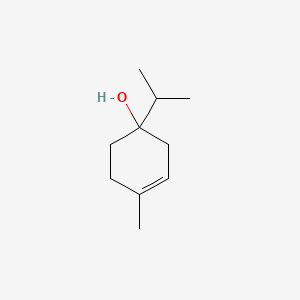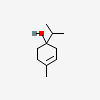4-Terpineol, (+/-)-
- Terpinen-4-ol
- 4-Carvomenthenol
- 562-74-3
- 4-Terpineol
- p-Menth-1-en-4-ol
- Create:2005-03-26
- Modify:2025-01-18

- (R)-1-isopropyl-4-methyl-3-cyclohexen-1-ol
- terpinen-4-ol
- terpinenol-4
- Terpinen-4-ol
- 4-Carvomenthenol
- 562-74-3
- 4-Terpineol
- p-Menth-1-en-4-ol
- 1-Terpinen-4-ol
- Terpinenol-4
- 1-p-Menthen-4-ol
- Terpene-4-ol
- 1-Menthene-4-ol
- rac Terpinen-4-ol
- TERPINENE-4-OL
- 1-para-Menthen-4-ol
- 3-Cyclohexen-1-ol, 4-methyl-1-(1-methylethyl)-
- (+-)-p-Menth-1-en-4-ol
- Melaleucol
- (+/-)-Terpinen-4-ol
- Terpinenolu-4
- Terpineol-4
- 4-Methyl-1-(1-methylethyl)-3-cyclohexen-1-ol
- dl-4-Terpineol
- FEMA No. 2248
- Terpinine-4-ol
- (+/-)-4-Terpineol
- para-Menth-1-en-4-ol
- 4-Carvomenthenol (natural)
- 1-Methyl-4-isopropyl-1-cyclohexen-4-ol
- 4-Methyl-1-isopropyl-3-cyclohexen-1-ol
- Terpin-4-en-1-ol
- CCRIS 9067
- NSC 147749
- 4-methyl-1-propan-2-ylcyclohex-3-en-1-ol
- EINECS 209-235-5
- EINECS 248-910-9
- UNII-L65MV77ZG6
- 4-Methyl-1-(propan-2-yl)cyclohex-3-en-1-ol
- alpha-terpinen-4-ol
- BRN 1906603
- L65MV77ZG6
- 1-isopropyl-4-methylcyclohex-3-en-1-ol
- CHEBI:78884
- 4-TERPINEOL, (+/-)-
- MFCD00001562
- NSC-147749
- DTXSID4044824
- HSDB 8264
- (1)-1-(Isopropyl)-4-methylcyclohex-3-en-1-ol
- 4-06-00-00250 (Beilstein Handbook Reference)
- TERPINEN-4-OL,(+/-)-
- 1-(ISOPROPYL)-4-METHYLCYCLOHEX-3-EN-1-OL
- METHYL-1-(1-METHYLETHYL)-3-CYCLOHEXEN-1-OL
- L-4-terpineneol
- L-4-terpineol
- L-terpinen-4-ol
- Terpinenolu-4 [Czech]
- (+/-)-1-Isopropyl-4-methyl-3-cyclohexen-1-ol
- Origanol
- (-)-Terpinen-4-ol (contains 30% (+)-Terpinen-4-ol at maximum)
- Terpinen 4-ol
- 1-isopropyl-4-methylcyclohex-3-enol
- (-)-1-Isopropyl-4-methyl-3-cyclohexen-1-ol
- alpha -Terpinen-4-ol
- 1-Isopropyl-4-methyl-3-cyclohexen-1-ol, (R)-
- 1-isopropyl-4-methyl-cyclohex-3-en-1-ol
- Terpinen-4-ol (Standard)
- SCHEMBL22344
- TERPINEN-4-OL [FCC]
- (-)-p-Menth-1-en-4-ol
- CHEMBL507795
- 4-CARVOMENTHENOL [FHFI]
- DTXCID2024824
- FEMA 2248
- (+/-)-p-Menth-1-en-4-ol
- HY-W017316R
- Tox21_301785
- AC1341
- NSC147749
- s6118
- AKOS015903412
- CS-W018032
- DB12816
- HY-W017316
- SB44714
- 4-Carvomenthenol, >=95%, FCC, FG
- NCGC00256250-01
- 1-Isopropyl-4-methyl-3-cyclohexen-1-ol
- 4-Carvomenthenol, natural, >=95%, FG
- AS-56462
- CAS-562-74-3
- DA-58415
- SY012857
- DB-066063
- DB-234185
- M0319
- NS00013199
- T1993
- C17073
- Q416114
- (-)-4-Hydroxy-4-isopropyl-1-methyl-1-cyclohexene
- (+/-)-4-Hydroxy-4-isopropyl-1-methyl-1-cyclohexene
- Terpinen 4-ol, primary pharmaceutical reference standard
71.0 99.99
111.0 52.64
43.0 44.78
93.0 43.32
41.0 32.84
71.0 99.99
111.0 61.07
93.0 59.60
86.0 48.75
69.0 38.56
54.01098 100
151.11385 26.50
57.03397 21.60
69.03412 10.50
80.0256 9.90
153.1307 100
54.01161 18.50
151.11431 10.80
68.00077 3.30
78.24482 2.70
54.01098 100
151.11385 26.50
57.03397 21.60
69.03412 10.50
80.0256 9.90
31.71729 100
41.24386 46.20
71 999
111 526
43 448
93 433
41 328
- Lavender Oil (part of)
- Juniper Berry Oil (part of)
- Peumus boldus leaf (part of)
(-)-Terpinen-4-ol (annotation moved to)
- Extracellular
- Membrane
Reported uses (ppm):
Table: Reported uses (ppm): (Flavor and Extract Manufacturers' Association, 1994)
Information on 10 consumer products that contain 4-Terpineol in the following categories is provided:
• Auto Products
• Inside the Home

H302 (> 99.9%): Harmful if swallowed [Warning Acute toxicity, oral]
H315 (98.4%): Causes skin irritation [Warning Skin corrosion/irritation]
H317 (12.4%): May cause an allergic skin reaction [Warning Sensitization, Skin]
H319 (96.6%): Causes serious eye irritation [Warning Serious eye damage/eye irritation]
H336 (13.9%): May cause drowsiness or dizziness [Warning Specific target organ toxicity, single exposure; Narcotic effects]
P261, P264, P264+P265, P270, P271, P272, P280, P301+P317, P302+P352, P304+P340, P305+P351+P338, P319, P321, P330, P332+P317, P333+P317, P337+P317, P362+P364, P403+P233, P405, and P501
(The corresponding statement to each P-code can be found at the GHS Classification page.)
Aggregated GHS information provided per 1985 reports by companies from 27 notifications to the ECHA C&L Inventory. Each notification may be associated with multiple companies.
Information may vary between notifications depending on impurities, additives, and other factors. The percentage value in parenthesis indicates the notified classification ratio from companies that provide hazard codes. Only hazard codes with percentage values above 10% are shown.
Acute Tox. 4 (> 99.9%)
Skin Irrit. 2 (98.4%)
Skin Sens. 1 (12.4%)
Eye Irrit. 2 (96.6%)
STOT SE 3 (13.9%)
Patents are available for this chemical structure:
https://patentscope.wipo.int/search/en/result.jsf?inchikey=WRYLYDPHFGVWKC-UHFFFAOYSA-N
- Australian Industrial Chemicals Introduction Scheme (AICIS)3-Cyclohexen-1-ol, 4-methyl-1-(1-methylethyl)-https://services.industrialchemicals.gov.au/search-inventory/
- CAS Common ChemistryLICENSEThe data from CAS Common Chemistry is provided under a CC-BY-NC 4.0 license, unless otherwise stated.https://creativecommons.org/licenses/by-nc/4.0/
- ChemIDplusChemIDplus Chemical Information Classificationhttps://pubchem.ncbi.nlm.nih.gov/source/ChemIDplus
- DrugBankLICENSECreative Common's Attribution-NonCommercial 4.0 International License (http://creativecommons.org/licenses/by-nc/4.0/legalcode)https://www.drugbank.ca/legal/terms_of_useTerpinen-4-olhttps://www.drugbank.ca/drugs/DB12816
- DTP/NCILICENSEUnless otherwise indicated, all text within NCI products is free of copyright and may be reused without our permission. Credit the National Cancer Institute as the source.https://www.cancer.gov/policies/copyright-reuse
- EPA Chemicals under the TSCA3-Cyclohexen-1-ol, 4-methyl-1-(1-methylethyl)-https://www.epa.gov/chemicals-under-tscaEPA TSCA Classificationhttps://www.epa.gov/tsca-inventory
- EPA DSSTox4-Methyl-1-(1-methylethyl)-3-cyclohexen-1-olhttps://comptox.epa.gov/dashboard/DTXSID4044824CompTox Chemicals Dashboard Chemical Listshttps://comptox.epa.gov/dashboard/chemical-lists/
- European Chemicals Agency (ECHA)LICENSEUse of the information, documents and data from the ECHA website is subject to the terms and conditions of this Legal Notice, and subject to other binding limitations provided for under applicable law, the information, documents and data made available on the ECHA website may be reproduced, distributed and/or used, totally or in part, for non-commercial purposes provided that ECHA is acknowledged as the source: "Source: European Chemicals Agency, http://echa.europa.eu/". Such acknowledgement must be included in each copy of the material. ECHA permits and encourages organisations and individuals to create links to the ECHA website under the following cumulative conditions: Links can only be made to webpages that provide a link to the Legal Notice page.https://echa.europa.eu/web/guest/legal-noticep-menth-1-en-4-olhttps://chem.echa.europa.eu/100.008.396p-menth-1-en-4-ol (EC: 209-235-5)https://echa.europa.eu/information-on-chemicals/cl-inventory-database/-/discli/details/71226
- FDA Global Substance Registration System (GSRS)LICENSEUnless otherwise noted, the contents of the FDA website (www.fda.gov), both text and graphics, are not copyrighted. They are in the public domain and may be republished, reprinted and otherwise used freely by anyone without the need to obtain permission from FDA. Credit to the U.S. Food and Drug Administration as the source is appreciated but not required.https://www.fda.gov/about-fda/about-website/website-policies#linking4-TERPINEOL, (±)-https://gsrs.ncats.nih.gov/ginas/app/beta/substances/L65MV77ZG6
- Hazardous Substances Data Bank (HSDB)
- Human Metabolome Database (HMDB)LICENSEHMDB is offered to the public as a freely available resource. Use and re-distribution of the data, in whole or in part, for commercial purposes requires explicit permission of the authors and explicit acknowledgment of the source material (HMDB) and the original publication (see the HMDB citing page). We ask that users who download significant portions of the database cite the HMDB paper in any resulting publications.http://www.hmdb.ca/citingp-Menth-1-en-4-olhttp://www.hmdb.ca/metabolites/HMDB0035833HMDB0035833_cms_28528https://hmdb.ca/metabolites/HMDB0035833#spectra
- International Fragrance Association (IFRA)LICENSE(c) The International Fragrance Association, 2007-2021. All rights reserved.https://ifrafragrance.org/links/copyright
- New Zealand Environmental Protection Authority (EPA)LICENSEThis work is licensed under the Creative Commons Attribution-ShareAlike 4.0 International licence.https://www.epa.govt.nz/about-this-site/general-copyright-statement/
- ChEBI
- LOTUS - the natural products occurrence databaseLICENSEThe code for LOTUS is released under the GNU General Public License v3.0.https://lotus.nprod.net/4-Carvomenthenolhttps://www.wikidata.org/wiki/Q416114LOTUS Treehttps://lotus.naturalproducts.net/
- Yeast Metabolome Database (YMDB)Terpinen-4-olhttps://www.ymdb.ca/compounds/YMDB01790
- ChEMBLLICENSEAccess to the web interface of ChEMBL is made under the EBI's Terms of Use (http://www.ebi.ac.uk/Information/termsofuse.html). The ChEMBL data is made available on a Creative Commons Attribution-Share Alike 3.0 Unported License (http://creativecommons.org/licenses/by-sa/3.0/).http://www.ebi.ac.uk/Information/termsofuse.htmlChEMBL Protein Target Treehttps://www.ebi.ac.uk/chembl/g/#browse/targets
- ClinicalTrials.govLICENSEThe ClinicalTrials.gov data carry an international copyright outside the United States and its Territories or Possessions. Some ClinicalTrials.gov data may be subject to the copyright of third parties; you should consult these entities for any additional terms of use.https://clinicaltrials.gov/ct2/about-site/terms-conditions#Use
- Comparative Toxicogenomics Database (CTD)LICENSEIt is to be used only for research and educational purposes. Any reproduction or use for commercial purpose is prohibited without the prior express written permission of NC State University.http://ctdbase.org/about/legal.jsp
- Consumer Product Information Database (CPID)LICENSECopyright (c) 2024 DeLima Associates. All rights reserved. Unless otherwise indicated, all materials from CPID are copyrighted by DeLima Associates. No part of these materials, either text or image may be used for any purpose other than for personal use. Therefore, reproduction, modification, storage in a retrieval system or retransmission, in any form or by any means, electronic, mechanical or otherwise, for reasons other than personal use, is strictly prohibited without prior written permission.https://www.whatsinproducts.com/contents/view/1/6Consumer Products Category Classificationhttps://www.whatsinproducts.com/
- EPA Chemical and Products Database (CPDat)4-Methyl-1-(propan-2-yl)cyclohex-3-en-1-olhttps://comptox.epa.gov/dashboard/DTXSID4044824#exposureEPA CPDat Classificationhttps://www.epa.gov/chemical-research/chemical-and-products-database-cpdat
- EU Food Improvement Agents
- Joint FAO/WHO Expert Committee on Food Additives (JECFA)LICENSEPermission from WHO is not required for the use of WHO materials issued under the Creative Commons Attribution-NonCommercial-ShareAlike 3.0 Intergovernmental Organization (CC BY-NC-SA 3.0 IGO) licence.https://www.who.int/about/policies/publishing/copyright
- FDA Substances Added to FoodLICENSEUnless otherwise noted, the contents of the FDA website (www.fda.gov), both text and graphics, are not copyrighted. They are in the public domain and may be republished, reprinted and otherwise used freely by anyone without the need to obtain permission from FDA. Credit to the U.S. Food and Drug Administration as the source is appreciated but not required.https://www.fda.gov/about-fda/about-website/website-policies#linking
- Flavor and Extract Manufacturers Association (FEMA)4-CARVOMENTHENOLhttps://www.femaflavor.org/flavor-library/4-carvomenthenol
- FooDBLICENSEFooDB is offered to the public as a freely available resource. Use and re-distribution of the data, in whole or in part, for commercial purposes requires explicit permission of the authors and explicit acknowledgment of the source material (FooDB) and the original publication.https://foodb.ca/aboutp-Menth-1-en-4-olhttps://foodb.ca/compounds/FDB014601
- MassBank Europe
- MassBank of North America (MoNA)LICENSEThe content of the MoNA database is licensed under CC BY 4.0.https://mona.fiehnlab.ucdavis.edu/documentation/license
- NIST Mass Spectrometry Data CenterLICENSEData covered by the Standard Reference Data Act of 1968 as amended.https://www.nist.gov/srd/public-law3-Cyclohexen-1-ol, 4-methyl-1-(1-methylethyl)-, (R)-http://www.nist.gov/srd/nist1a.cfm
- SpectraBase4-TERPINEOLhttps://spectrabase.com/spectrum/JrADNctTDMn3-CYCLOHEXEN-1-OL, 4-METHYL-1-(1-METHYLETHYL)-https://spectrabase.com/spectrum/DnHbJ4pA4gsTerpinen-4-olhttps://spectrabase.com/spectrum/15kCFhqlz8wp-MENTH-1-EN-4-OLhttps://spectrabase.com/spectrum/AsX2m9ad1B23-CYCLOHEXEN-1-OL, 4-METHYL-1-(1-METHYLETHYL)-https://spectrabase.com/spectrum/60A0nu45s4b(±)-Terpinen-4-olhttps://spectrabase.com/spectrum/7d2fsSMXTF9Terpinen-4-olhttps://spectrabase.com/spectrum/EYfBJB4pKH7(±)-Terpinen-4-olhttps://spectrabase.com/spectrum/C5WB2T8B7waTerpinen-4-olhttps://spectrabase.com/spectrum/5XUP9eeSPkC(±)-Terpinen-4-olhttps://spectrabase.com/spectrum/78LbZnVHRvv4-Carvomenthenolhttps://spectrabase.com/spectrum/ZLvxNZUDdZ3-Cyclohexen-1-ol, 4-methyl-1-(1-methylethyl)-https://spectrabase.com/spectrum/EfEfaYFgo6B3-Cyclohexen-1-ol, 4-methyl-1-(1-methylethyl)-https://spectrabase.com/spectrum/I8wnWnTLK7KTerpinen-4-olhttps://spectrabase.com/spectrum/JSZhxKEmx7TTerpinen-4-olhttps://spectrabase.com/spectrum/Ex0H0cKEVzu
- Japan Chemical Substance Dictionary (Nikkaji)
- KEGGLICENSEAcademic users may freely use the KEGG website. Non-academic use of KEGG generally requires a commercial licensehttps://www.kegg.jp/kegg/legal.html
- Natural Product Activity and Species Source (NPASS)
- NORMAN Suspect List ExchangeLICENSEData: CC-BY 4.0; Code (hosted by ECI, LCSB): Artistic-2.0https://creativecommons.org/licenses/by/4.0/Terpinen-4-olNORMAN Suspect List Exchange Classificationhttps://www.norman-network.com/nds/SLE/
- NLM RxNorm TerminologyLICENSEThe RxNorm Terminology is created by the National Library of Medicine (NLM) and is in the public domain and may be republished, reprinted and otherwise used freely by anyone without the need to obtain permission from NLM. Credit to the U.S. National Library of Medicine as the source is appreciated but not required. The full RxNorm dataset requires a free license.https://www.nlm.nih.gov/research/umls/rxnorm/docs/termsofservice.html4-methyl-1-(1-methylethyl)-3-cyclohexen-1-olhttps://rxnav.nlm.nih.gov/id/rxnorm/1314261
- Rhea - Annotated Reactions DatabaseLICENSERhea has chosen to apply the Creative Commons Attribution License (http://creativecommons.org/licenses/by/4.0/). This means that you are free to copy, distribute, display and make commercial use of the database in all legislations, provided you credit (cite) Rhea.https://www.rhea-db.org/help/license-disclaimer
- Springer Nature
- Thieme ChemistryLICENSEThe Thieme Chemistry contribution within PubChem is provided under a CC-BY-NC-ND 4.0 license, unless otherwise stated.https://creativecommons.org/licenses/by-nc-nd/4.0/
- Wikidata(+/-)-4-terpineolhttps://www.wikidata.org/wiki/Q416114
- WikipediaIduronic acidhttps://en.wikipedia.org/wiki/Iduronic_acidTerpinen-4-olhttps://en.wikipedia.org/wiki/Terpinen-4-ol
- PubChem
- Medical Subject Headings (MeSH)LICENSEWorks produced by the U.S. government are not subject to copyright protection in the United States. Any such works found on National Library of Medicine (NLM) Web sites may be freely used or reproduced without permission in the U.S.https://www.nlm.nih.gov/copyright.htmlterpinenol-4https://www.ncbi.nlm.nih.gov/mesh/67034019
- GHS Classification (UNECE)GHS Classification Treehttp://www.unece.org/trans/danger/publi/ghs/ghs_welcome_e.html
- EPA Substance Registry ServicesEPA SRS List Classificationhttps://sor.epa.gov/sor_internet/registry/substreg/LandingPage.do
- MolGenieMolGenie Organic Chemistry Ontologyhttps://github.com/MolGenie/ontology/
- PATENTSCOPE (WIPO)SID 403385620https://pubchem.ncbi.nlm.nih.gov/substance/403385620









